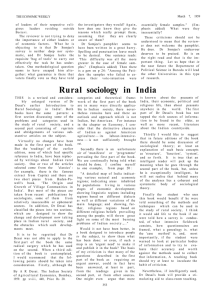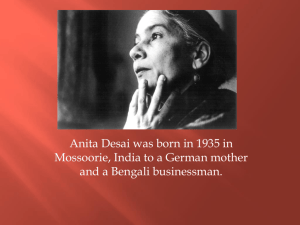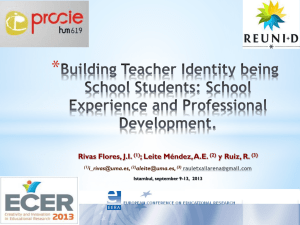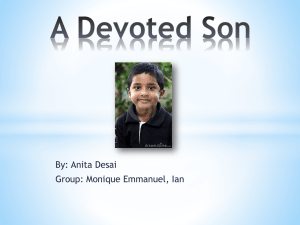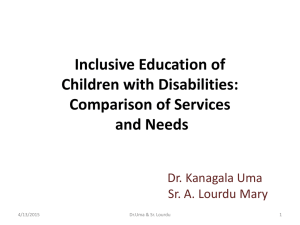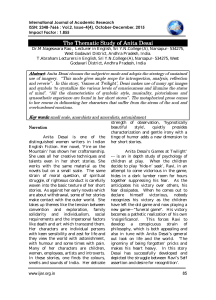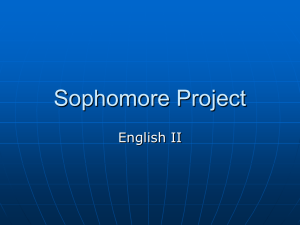Anita Desai - Colorado Mesa University
advertisement
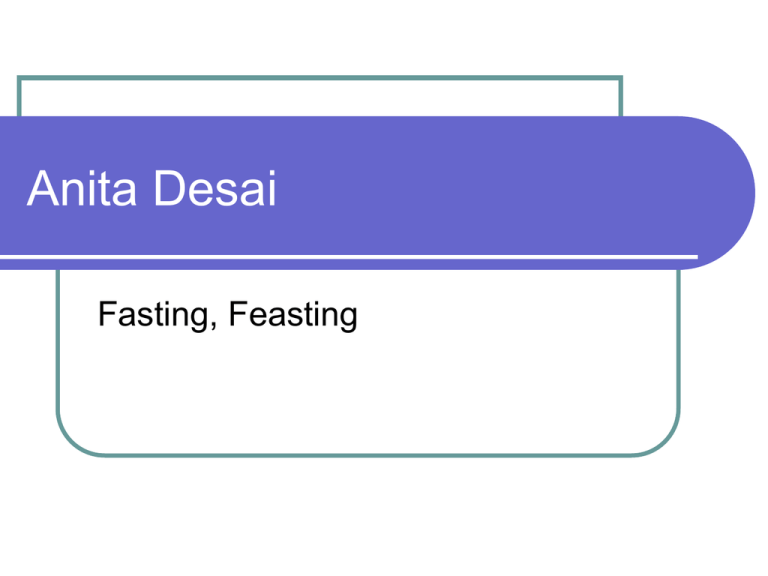
Anita Desai Fasting, Feasting Desai and Style Desai is often praised as a stylist, in particular for her use of imagery. She has been referred to by reviewers as an “imagist novelist . . . [Her use of images] is a remarkable quality of her craft.” Where are there particularly powerful images in Fasting, Feasting? Desai claims that novels give her the scope to reshape and reuse images, to make their meanings flexible and polyvalent. Where do you find her “recycling” images in the text? Woman’s Language In a review of the novel in feminista!, Lakshmi Chandra says that “Desai uses ‘woman’s language’ not only through her women protagonists, but also in her narrative style.” Here are the qualities which she claims create “woman’s language”: The need to use modifiers in declaratives to make the woman sound polite The use of declaratives with an interrogative intonation Plurality of meaning Refinement Tact Knowledge of domestic details Fluency Open ended conclusion Do you agree that these are elements of “women’s langage”? Can you find evidence of them in Desai’s text? Uma Frederick Luis Aldama, in World Literature Today, says that “the last thing Uma desires is a man.” Rather, he says, Uma “hungers for a world without men and seeks the companionship of other women, like her widowed aunt, Mira-masi.” He continues: “Mira-masi seems to be an appropriate role model for Uma; she too is an outsider. Her grand holy pilgrimages, Hindu chants, and frequent ashram sojourns make her the family outcast. However, like other socially different female role models Uma looks to, Mira-masi turns out to be so self-centered that she ultimately fails to give Uma the attention she thirsts for. What do you think? Who are her other female role models? Are they self-centered, too? Fasting, Feasting Lakshmi Chandra, in a review of the novel for feminista! observes that all of the chapters in part I, except for the last one, are divided into two sections, one written in the present tense and one in the past. She says, “I think that Desai feels that living in the present is a kind of fasting while you can feast on the past.” Do you agree or disagree with this observation? Humor? Desai says that although “a lot of people tell me my books are extremely pessimistic, and extremely dark, . . . I would prefer to think of them as facing the truth, not having illusions. But, I do make an attempt also to show the fact that India is full of laughter; even in a family like Uma’s there’s room for humor. What do you think? “The Plain Face of Truth” If what Fasting, Feasting reveals is “the plain face of truth” (see dedication) can Desai herself also be said to connive at women’s entrapment? For one of the questions we take away with us is: what freedom can there ever be for women like Uma, since the routes laid down are undeviatingly marriage, which either casts one as a victim or a tyrant, or, outside of marriage, the religious life? What else? Unless it is “the burning ground,” or the deep river where swept by the current, Uma feels not fear or danger but “something darker, wilder, more thrilling, a kind of exultation.” Shirley Chew – Review in the Times Literary Supplement Next Slide before discussion. Narration and Purpose Frederic Jameson has said that narrative is a socially symbolic act that tries to affect the world indirectly. We try to make sense of the world we live in by telling stories. This being the case, Lakshmi Chandra wants to ask Desai this question: “If we can change the world by changing the stories we tell, should not we at least try to change the stories we tell?” Is Desai’s story disempowering because it only reports, repeats the actual, instead of attempting to restructure it, instead of offering possibilities beyond those Uma and the other woman in her life must deal with? Families Everywhere Desai says that the contrast in families in Fasting, Feasting is “about the fact that, no matter where you travel, you come across the same emotional hungers and needs. What is different is our ways of satisfying them. In India one imagines religion should satisfy them. If you have nothing else in the world at least you have religion. In America people think that a trip to the shopping mall is best.” One critic says that the Part II of the novel asks the question: How close can we get to understanding the needs and hungers of others? As an outsider and an observer, Arun sees the likenesses and differences between his new life and the one he left behind, yet he doesn’t necessarily understand what he sees. Do you agree? Or not? Why? The Pattons . . . Coatzee, the Pulitzer Prize winner from South Africa says this about Arun and the Pattons: Arriving in the United States, Arun had exulted in his newfound anonymity; ‘no past, no family . . . No country.’ But he has not escaped family after all, just stumbled into a plastic representation of it.” Do the Pattons represent American families? How does Desai capture and/or stereotype American families through the Pattons? The Pattons still The Pattons, with their excesses, counter the Indian household, says one critic. Why does Mrs. Patton’s complaisance towards her husband recall Arun’s mother’s more evasive tactics? (194) Why does Rod’s assiduous pursuit of health resemble the pressure Arun is under to perform a role, to be worth all the trouble and effort and expense? Why does Melanie’s anger have “the contorted face of an enraged sister who spits and froths in ineffectual protest?” (214) Why does Mr. Patton’s expression when thwarted remind Arun of his own father? (185-186) Shirley Chew’s review in Times Literary Supplement The Pattons some more Earlier, I quoted Chandra who said that the novel is about fasting in the present and feasting on the past. She also claims that this luxury of feasting on the past “is denied to the Pattons, who are condemned to a life in the present tense – which for them is a kind of feasting. Melanie’s bulimia could be a direct result of too much feasting, perhaps symbolic of American consumerism as a whole.” At one point in the novel, Arun is surprised to see the look of deprivation, neglect and misunderstanding he saw so often on Uma’s face on Melanie’s. He ponders the question “What is plenty? What is not? Can one tell the difference?” (214). What does Desai say about the difference? Arun “Arun himself, as he picks his way through a minefield of puzzling American customs, becomes a more sympathetic character, and his final act in the novel suggests both how far he has come and how much he has lost,” says a critic for Publisher’s Weekly. How far has he come? How much has he lost? Part II Several critics of the novel have said that Part II of the novel ruins it. For example, Gabriele Annan in the London Review of Books, claims that “Uma would be better off if she had her touching and fastidiously written novella to herself, and Arun were consigned to the sacred river.” And, Frederick Luis Aldama writing for World Literature Today, asserts that Desai would have written a better novel if she’d have spent more time fleshing out Uma. He says that “in spite of the novel’s half-baked denouement, Fasting, Feasting is an exquisitely told, powerfully tragic story of the Umas, and the Melanies, of the world who are born gasping for air in a genderimbalanced social order. What do you think?
